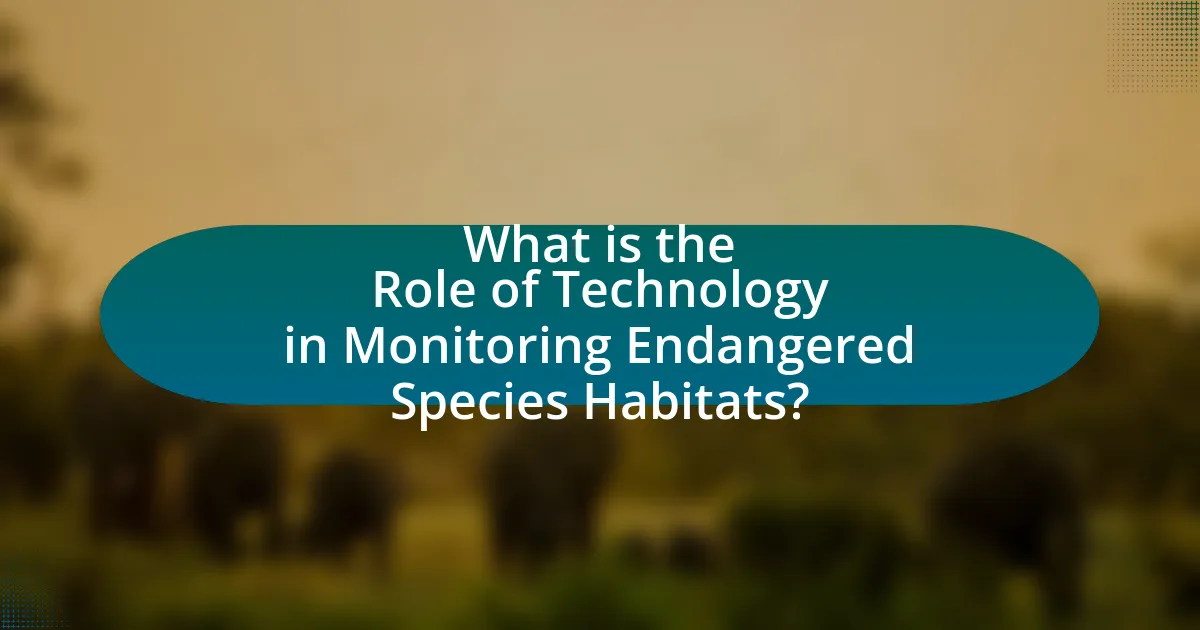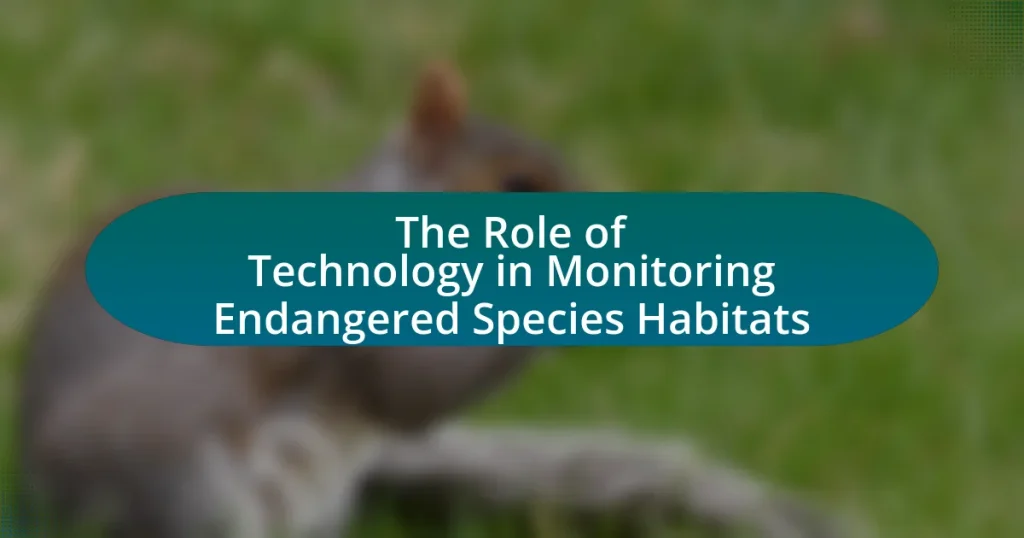The article focuses on the critical role of technology in monitoring endangered species habitats. It highlights various technological tools, such as remote sensing, GPS tracking, and camera traps, that facilitate data collection and analysis, enabling researchers to assess habitat conditions and identify threats like climate change and poaching. The discussion includes the importance of accurate data for effective conservation strategies, the challenges faced by conservationists, and the advancements shaping the future of habitat monitoring. Additionally, it emphasizes collaborative approaches and best practices to enhance the effectiveness of these technologies in supporting biodiversity conservation.

What is the Role of Technology in Monitoring Endangered Species Habitats?
Technology plays a crucial role in monitoring endangered species habitats by providing tools for data collection, analysis, and real-time monitoring. Remote sensing technologies, such as satellite imagery and drones, enable researchers to assess habitat conditions and changes over time, allowing for the identification of threats like deforestation or climate change. Additionally, GPS tracking devices and camera traps facilitate the study of animal movements and behaviors, offering insights into population dynamics and habitat use. For instance, a study published in the journal “Ecological Applications” demonstrated that GPS collars on endangered species improved understanding of their spatial ecology, leading to more effective conservation strategies. Thus, technology enhances the ability to monitor and protect endangered species habitats effectively.
How does technology contribute to the conservation of endangered species?
Technology significantly contributes to the conservation of endangered species by enabling precise monitoring and data collection in their habitats. Tools such as satellite imagery and drones allow researchers to track animal movements, assess habitat conditions, and identify threats like poaching or habitat destruction in real-time. For instance, the use of GPS collars on species like the African elephant has provided critical data on migration patterns and habitat use, leading to more effective conservation strategies. Additionally, camera traps have revolutionized wildlife monitoring by capturing images of elusive species, which helps in population assessments and understanding behavioral patterns. These technological advancements enhance the ability to implement targeted conservation efforts, ultimately improving the chances of survival for endangered species.
What types of technology are commonly used in habitat monitoring?
Commonly used technologies in habitat monitoring include remote sensing, GPS tracking, camera traps, and acoustic monitoring systems. Remote sensing utilizes satellite imagery and aerial photography to assess habitat conditions over large areas, providing data on vegetation cover and land use changes. GPS tracking allows researchers to monitor the movements and behaviors of endangered species in real-time, offering insights into their habitat use. Camera traps capture images of wildlife, enabling the study of species presence and population dynamics without human interference. Acoustic monitoring systems record sounds in the environment, helping to detect species presence and assess biodiversity. These technologies collectively enhance the understanding of habitat conditions and species interactions, crucial for conservation efforts.
How do these technologies enhance data collection and analysis?
Technologies such as remote sensing, GPS tracking, and data analytics significantly enhance data collection and analysis in monitoring endangered species habitats. Remote sensing allows for the acquisition of large-scale environmental data, enabling researchers to assess habitat changes over time with high spatial resolution. GPS tracking provides precise location data on species movements, facilitating the understanding of their habitat use and migration patterns. Data analytics tools process and interpret vast amounts of collected data, revealing trends and correlations that inform conservation strategies. For instance, studies have shown that integrating these technologies can improve the accuracy of habitat assessments by up to 30%, thereby enhancing the effectiveness of conservation efforts.
Why is monitoring endangered species habitats important?
Monitoring endangered species habitats is crucial for conservation efforts and biodiversity preservation. By tracking habitat conditions, researchers can identify threats such as climate change, habitat destruction, and pollution that impact these species. For instance, studies show that habitat loss is a primary driver of species extinction, with approximately 1 million species at risk due to human activities. Monitoring allows for timely interventions, such as habitat restoration and protection measures, ensuring the survival of vulnerable species and maintaining ecosystem balance.
What are the ecological impacts of losing endangered species?
Losing endangered species leads to significant ecological impacts, including the disruption of ecosystem balance and loss of biodiversity. When a species becomes extinct, it can create a ripple effect, affecting food chains and habitat stability. For example, the extinction of a predator can lead to overpopulation of prey species, which in turn can result in overgrazing and habitat degradation. According to a study published in the journal “Nature,” the loss of biodiversity can reduce ecosystem resilience, making it more difficult for ecosystems to recover from disturbances such as climate change or natural disasters. Additionally, endangered species often play unique roles in their ecosystems, such as pollination or seed dispersal, which are critical for the survival of other species and overall ecosystem health.
How does habitat monitoring support biodiversity conservation?
Habitat monitoring supports biodiversity conservation by providing essential data on ecosystem health and species populations. This data enables conservationists to identify changes in habitats, assess threats, and implement targeted management strategies. For instance, studies have shown that regular monitoring can lead to the early detection of invasive species, which can threaten native biodiversity. Additionally, habitat monitoring technologies, such as remote sensing and GPS tracking, have been proven to enhance the accuracy of data collection, allowing for more effective conservation efforts.
What challenges do conservationists face in monitoring habitats?
Conservationists face significant challenges in monitoring habitats, primarily due to limited funding and resources. These constraints hinder the ability to deploy advanced technologies and conduct comprehensive field studies necessary for effective habitat assessment. For instance, a study published in “Conservation Biology” highlights that inadequate financial support often results in insufficient data collection, which is critical for understanding ecosystem dynamics and species interactions. Additionally, the complexity of ecosystems and the variability of environmental conditions complicate monitoring efforts, making it difficult to obtain consistent and reliable data.
How do technological limitations affect monitoring efforts?
Technological limitations significantly hinder monitoring efforts by restricting data collection, analysis, and real-time reporting capabilities. For instance, inadequate sensor accuracy can lead to misinterpretation of species presence or habitat conditions, which directly impacts conservation strategies. A study published in the journal “Ecological Applications” highlights that limited satellite imagery resolution can obscure critical habitat features, making it difficult to assess changes over time. Furthermore, insufficient data storage and processing power can delay the analysis of collected information, resulting in outdated or ineffective management decisions. These limitations collectively undermine the effectiveness of monitoring endangered species habitats, ultimately jeopardizing conservation efforts.
What are the financial constraints associated with habitat monitoring technologies?
Financial constraints associated with habitat monitoring technologies include high initial investment costs, ongoing maintenance expenses, and the need for specialized training. The initial costs can range from thousands to millions of dollars depending on the technology used, such as drones or remote sensing equipment. Ongoing maintenance can add significant expenses, as equipment requires regular updates and repairs. Additionally, specialized training for personnel to effectively use and interpret data from these technologies incurs further costs. For instance, a study by the National Oceanic and Atmospheric Administration (NOAA) highlighted that the deployment of advanced monitoring systems can exceed budgetary limits for many conservation programs, limiting their implementation and effectiveness.
How can technology improve the effectiveness of monitoring efforts?
Technology can improve the effectiveness of monitoring efforts by enabling real-time data collection and analysis through advanced tools such as remote sensing, GPS tracking, and automated camera systems. These technologies allow researchers to gather precise information about endangered species and their habitats, facilitating timely interventions. For instance, satellite imagery can monitor habitat changes over large areas, while GPS collars provide detailed movement patterns of species, enhancing understanding of their behaviors and threats. Studies have shown that the use of drones for aerial surveys can increase data accuracy and reduce the time needed for field assessments, leading to more effective conservation strategies.
What advancements in technology are shaping the future of habitat monitoring?
Advancements in technology shaping the future of habitat monitoring include the use of remote sensing, artificial intelligence, and Internet of Things (IoT) devices. Remote sensing technologies, such as satellite imagery and drones, enable researchers to collect large-scale environmental data efficiently, allowing for real-time monitoring of habitat changes. Artificial intelligence algorithms analyze this data to identify patterns and predict ecological trends, enhancing decision-making processes. IoT devices, including sensors deployed in various ecosystems, facilitate continuous data collection on temperature, humidity, and wildlife movements, providing critical insights into habitat health. These technologies collectively improve the accuracy and efficiency of habitat monitoring, supporting conservation efforts for endangered species.
How are drones and satellite imagery utilized in habitat monitoring?
Drones and satellite imagery are utilized in habitat monitoring by providing high-resolution data and real-time observations of ecosystems. Drones can capture detailed aerial images and collect data on vegetation health, species distribution, and habitat changes, while satellite imagery offers broader coverage and can track changes over time across large areas. For instance, studies have shown that drones can achieve resolutions as fine as 1-3 cm, enabling precise assessments of habitat conditions, which is crucial for monitoring endangered species. Additionally, satellite data, such as that from Landsat or Sentinel missions, allows researchers to analyze long-term trends in habitat loss or degradation, supporting conservation efforts.
What role do mobile applications play in data collection for conservationists?
Mobile applications serve a crucial role in data collection for conservationists by enabling real-time monitoring and reporting of wildlife and habitat conditions. These applications facilitate the gathering of data through user-friendly interfaces that allow conservationists and citizen scientists to input observations, track species movements, and report environmental changes. For instance, platforms like iNaturalist and eBird have amassed millions of user-generated records, significantly contributing to biodiversity databases. This data is essential for making informed conservation decisions, as it helps identify trends, assess species health, and evaluate the effectiveness of conservation strategies.
What best practices should be followed when using technology for monitoring?
Best practices for using technology in monitoring endangered species habitats include ensuring data accuracy, utilizing appropriate technology, maintaining ethical standards, and fostering collaboration among stakeholders. Accurate data collection is crucial; for instance, using GPS collars on animals can provide precise location data, which is essential for understanding habitat use. Selecting the right technology, such as drones for aerial surveys, enhances monitoring efficiency and coverage. Ethical considerations, such as minimizing disturbance to wildlife during monitoring, are vital to maintain the integrity of the species and their habitats. Collaboration with local communities and conservation organizations can improve data sharing and resource allocation, leading to more effective monitoring outcomes. These practices are supported by studies indicating that integrated approaches yield better conservation results, as seen in the work of the World Wildlife Fund and various academic research on wildlife monitoring techniques.
How can data accuracy be ensured in technological monitoring methods?
Data accuracy in technological monitoring methods can be ensured through the implementation of robust calibration protocols and validation processes. Calibration involves adjusting the monitoring equipment to ensure it provides accurate readings, while validation confirms that the data collected aligns with known standards or benchmarks. For instance, using satellite imagery to monitor endangered species habitats requires regular calibration against ground-truth data to account for changes in environmental conditions. Studies have shown that employing multiple data sources, such as combining remote sensing with field surveys, enhances accuracy by cross-verifying information. This multi-faceted approach reduces errors and increases the reliability of the data collected for monitoring endangered species habitats.
What collaborative approaches can enhance the effectiveness of monitoring technologies?
Collaborative approaches that can enhance the effectiveness of monitoring technologies include partnerships between governmental agencies, non-profit organizations, and local communities. These collaborations facilitate data sharing, resource pooling, and the integration of local knowledge, which improves the accuracy and comprehensiveness of monitoring efforts. For instance, the use of citizen science initiatives, where local volunteers assist in data collection, has been shown to significantly increase the volume of data gathered while also fostering community engagement in conservation efforts. Research published in “Biological Conservation” by Daniel J. Lechner et al. (2020) highlights that such collaborative frameworks can lead to more effective monitoring outcomes by leveraging diverse expertise and perspectives.


